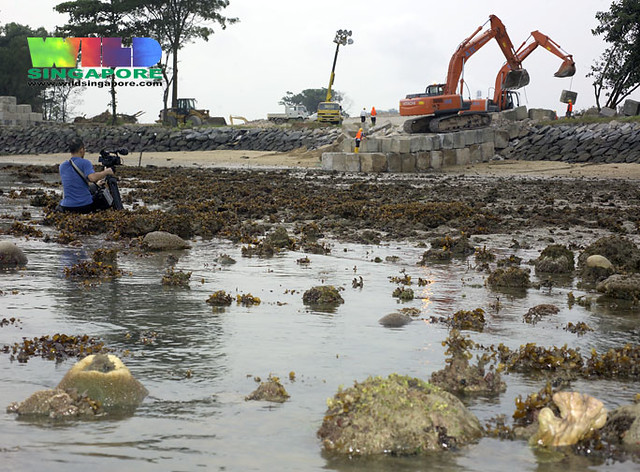 |
| Living reefs at Sentosa, buried in reclamation for Resorts World Sentosa, Jan 2000. |
Excepts from the Straits Times articles
- Bold moves in infrastructure: Thinking big pays off for Singapore planners Ng Jun Sen Straits Times 4 Feb 18;
- Building boldly: 5 things you might not know about infrastructure planning in Singapore Straits Times 4 Feb 18;
- New ideas to feed a growing island Ng Jun Sen Straits Times 4 Feb 18;
Land reclamation to continue
Land reclamation will continue to be an important way for Singapore to overcome its land constraints."
In recent years, the Republic has turned to a Dutch reclamation method called empoldering, that can save 40 per cent in sand volume and construction costs, said Mr Wong."
The method is being used in Pulau Tekong, which is set to grow by 810 ha, or the size or Toa Payoh, by 2022. The added land will be used for military training, freeing up space on the mainland - in Tengah - for housing.
Empoldering at Tekong from the HDB Youtube channel
Ecological impact of our reclamation on sand source countries
"Asked about complaints in Cambodia by local environmental groups that alleged sand had been illegally exported to Singapore, Mr Wong said: "The key thing is that all procurement agencies that procure sand from commercial providers will require requisite permits from the source countries - that is the ultimate check."
"We will not allow for any commercial provider of sand to come in without a valid export permit."
Not all areas identified to be of reclamation potential have seen reclamation works yet. Works only begin when there is a developmental need.
"In doing so, we make sure that we do all the necessary impact assessments, environmental impact assessments and a range of studies to make sure that whatever we are doing is sustainable," Mr Wong added.
 |
| Massive reclamation at Pasir Panjang, next to Labrador Nature Reserve, Jan 2012. |
Not all planned reclamation will go ahead
Another plan that has not yet been implemented is the Long Island Project.
Under this plan, an island would be reclaimed off East Coast Park for recreation and premium waterfront housing.
This plan was set aside because of a lack of demand for it, said Ms Hwang.
"People love East Coast Park, so do we really want to commit to the plan if we don't need it? Some of these options can be safeguarded for future use," she said.
"If we need to dust off these plans later on, we would have already studied the idea."
Mr Wong said: "We have to do our due diligence; we have to study all options. We have to consider all possibilities as we go about planning for the future."
"When we do that, you may not want to embark on everything."
The landuse plan by the Ministry of National Development released in 2013 shows some of the shores that may be lost as part of plans for 6.9 million population by 2030. These plans include reclamation (in yellow) at the East Coast, as well as Chek Jawa, Pulau Sekudu, Changi shores, Mandai mangroves and probably Pasir Ris mangroves too. More about the shores that we might lose in this plan in an old blog post here.

Floating cities on the sea?
Another idea to overcome space constraints here is building on sea - or using large "floating vessels" that can support big structures, including buildings.
Ms Hwang said the Government is studying this idea, but one key obstacle is that maritime space is already very crowded.
One solution currently being examined is whether ships can be parked using four-point anchors, which will reduce the space they need, as the current one-point anchor causes ships to drift in a circle.
"With proper anchoring, we can make our sea space more efficient and potentially make ideas like floating vessels (that one can build structures on) be more practical to implement," she said.
 |
| Shipping next to living Cyrene Reef, May 2008. |
Related links
More blog posts about reclamation in Singapore.
